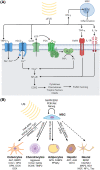The role of ultrasound in enhancing mesenchymal stromal cell-based therapies
- PMID: 32157802
- PMCID: PMC7381806
- DOI: 10.1002/sctm.19-0391
The role of ultrasound in enhancing mesenchymal stromal cell-based therapies
Abstract
Mesenchymal stromal cells (MSCs) have been a popular platform for cell-based therapy in regenerative medicine due to their propensity to home to damaged tissue and act as a repository of regenerative molecules that can promote tissue repair and exert immunomodulatory effects. Accordingly, a great deal of research has gone into optimizing MSC homing and increasing their secretion of therapeutic molecules. A variety of methods have been used to these ends, but one emerging technique gaining significant interest is the use of ultrasound. Sound waves exert mechanical pressure on cells, activating mechano-transduction pathways and altering gene expression. Ultrasound has been applied both to cultured MSCs to modulate self-renewal and differentiation, and to tissues-of-interest to make them a more attractive target for MSC homing. Here, we review the various applications of ultrasound to MSC-based therapies, including low-intensity pulsed ultrasound, pulsed focused ultrasound, and extracorporeal shockwave therapy, as well as the use of adjunctive therapies such as microbubbles. At a molecular level, it seems that ultrasound transiently generates a local gradient of cytokines, growth factors, and adhesion molecules that facilitate MSC homing. However, the molecular mechanisms underlying these methods are far from fully elucidated and may differ depending on the ultrasound parameters. We thus put forth minimal criteria for ultrasound parameter reporting, in order to ensure reproducibility of studies in the field. A deeper understanding of these mechanisms will enhance our ability to optimize this promising therapy to assist MSC-based approaches in regenerative medicine.
Keywords: cell therapy; extracorporeal shockwave therapy; focused ultrasound; homing; low-intensity ultrasound; mesenchymal stromal cells; regenerative medicine; ultrasound.
© 2020 The Authors. STEM CELLS TRANSLATIONAL MEDICINE published by Wiley Periodicals LLC on behalf of AlphaMed Press.
Conflict of interest statement
The authors declared no potential conflicts of interest.
Figures



Similar articles
-
MR-guided pulsed focused ultrasound improves mesenchymal stromal cell homing to the myocardium.J Cell Mol Med. 2020 Nov;24(22):13278-13288. doi: 10.1111/jcmm.15944. Epub 2020 Oct 17. J Cell Mol Med. 2020. PMID: 33067927 Free PMC article.
-
Pulsed focused ultrasound enhances the therapeutic effect of mesenchymal stromal cell-derived extracellular vesicles in acute kidney injury.Stem Cell Res Ther. 2020 Sep 14;11(1):398. doi: 10.1186/s13287-020-01922-1. Stem Cell Res Ther. 2020. PMID: 32928310 Free PMC article.
-
Role of iron and iron-related proteins in mesenchymal stem cells: Cellular and clinical aspects.J Cell Physiol. 2021 Oct;236(10):7266-7289. doi: 10.1002/jcp.30383. Epub 2021 Apr 5. J Cell Physiol. 2021. PMID: 33821487 Review.
-
Cyclooxygenase-2 or tumor necrosis factor-α inhibitors attenuate the mechanotransductive effects of pulsed focused ultrasound to suppress mesenchymal stromal cell homing to healthy and dystrophic muscle.Stem Cells. 2015 Apr;33(4):1173-86. doi: 10.1002/stem.1927. Stem Cells. 2015. PMID: 25534849 Free PMC article.
-
Mesenchymal Stromal Cell Homing: Mechanisms and Strategies for Improvement.iScience. 2019 May 31;15:421-438. doi: 10.1016/j.isci.2019.05.004. Epub 2019 May 9. iScience. 2019. PMID: 31121468 Free PMC article. Review.
Cited by
-
MR-guided pulsed focused ultrasound improves mesenchymal stromal cell homing to the myocardium.J Cell Mol Med. 2020 Nov;24(22):13278-13288. doi: 10.1111/jcmm.15944. Epub 2020 Oct 17. J Cell Mol Med. 2020. PMID: 33067927 Free PMC article.
-
Unveiling the morphogenetic code: A new path at the intersection of physical energies and chemical signaling.World J Stem Cells. 2021 Oct 26;13(10):1382-1393. doi: 10.4252/wjsc.v13.i10.1382. World J Stem Cells. 2021. PMID: 34786150 Free PMC article. Review.
-
Latest progress in low-intensity pulsed ultrasound for studying exosomes derived from stem/progenitor cells.Front Endocrinol (Lausanne). 2023 Nov 28;14:1286900. doi: 10.3389/fendo.2023.1286900. eCollection 2023. Front Endocrinol (Lausanne). 2023. PMID: 38089611 Free PMC article. Review.
-
Role of CD9 Sensing, AI, and Exosomes in Cellular Communication of Cancer.Int J Stem Cell Res Ther. 2023;10(1):079. doi: 10.23937/2469-570X/1410079. Epub 2023 May 20. Int J Stem Cell Res Ther. 2023. PMID: 37475778 Free PMC article.
-
Pulsed focused ultrasound enhances the therapeutic effect of mesenchymal stromal cell-derived extracellular vesicles in acute kidney injury.Stem Cell Res Ther. 2020 Sep 14;11(1):398. doi: 10.1186/s13287-020-01922-1. Stem Cell Res Ther. 2020. PMID: 32928310 Free PMC article.
References
-
- Chapel A, Bertho JM, Bensidhoum M, et al. Mesenchymal stem cells home to injured tissues when co‐infused with hematopoietic cells to treat a radiation‐induced multi‐organ failure syndrome. J Gene Med. 2003;5(12):1028‐1038. - PubMed
-
- Friedenstein AJ et al. Heterotopic of bone marrow. Analysis of precursor cells for osteogenic and hematopoietic tissues. Transplantation. 1968;6(2):230‐247. - PubMed
-
- Young HE, Steele TA, Bray RA, et al. Human reserve pluripotent mesenchymal stem cells are present in the connective tissues of skeletal muscle and dermis derived from fetal, adult, and geriatric donors. Anat Rec. 2001;264(1):51‐62. - PubMed

